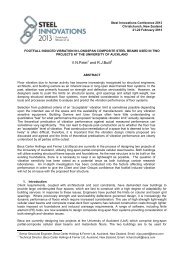Environmental Impacts of Multi-Storey Buildings Using Different ...
Environmental Impacts of Multi-Storey Buildings Using Different ...
Environmental Impacts of Multi-Storey Buildings Using Different ...
You also want an ePaper? Increase the reach of your titles
YUMPU automatically turns print PDFs into web optimized ePapers that Google loves.
- 25 -4 The <strong>Buildings</strong>4.1 Construction Materials for Commercial <strong>Buildings</strong>Most commercial buildings tend to make extensive use <strong>of</strong> steel, glass, and concrete materialsin construction, all <strong>of</strong> which can be energy-intensive to produce, via processes that have thepotential to cause adverse environmental impacts and utilising resources that are in shorteningsupply.However, recent developments in wood technology and engineered timber products, seismicand acoustic design, fabrication and construction techniques have enabled timber to beutilised much more extensively for the basic structure <strong>of</strong> medium-rise, multi-storey buildings,such as a typical ‘down-town’ <strong>of</strong>fice block.While there is a tendency for commercial buildings to be labelled according to the mainmaterial used for their sub-structure and super-structure, the vast majority <strong>of</strong> buildings use alarge number <strong>of</strong> different materials, from a variety <strong>of</strong> sources, both national and international.From a materials perspective, a building becomes a very complex system and it is <strong>of</strong>ten notimmediately clear which materials or combinations <strong>of</strong> materials provide the bestenvironmental performance (in terms <strong>of</strong> life–cycle energy use and GWP, for example). Whileconscious <strong>of</strong> these limitations, this report will retain this labelling system as it is currentpractice.Studies have indicated that typically structural components account for between 16 and 65per cent <strong>of</strong> initial embodied energy (Aye, Bamford, Charters, & Robinson, 1999; Cole &Kernan, 1996; Oppenheim & Treloar, 1995; Treloar, Fay, Ilozor, & Love, 2001). Hence,when considering the environmental impacts <strong>of</strong> building materials, the structural componentsused in a building are <strong>of</strong> significant importance.This report emphasises alternative structural design options where the predominant structuralmaterial is either concrete, steel or timber.4.2 Building DesignThere are two main aspects in the design <strong>of</strong> a multi-storey building. The structural designconsiders all the main structural components - the skeleton - including the foundation, thebeams, columns, external walls, as well as the internal flooring system and ro<strong>of</strong> structure.The architectural design provides the external cladding including windows and louvres,internal walls, insulation, etc.. In some areas, the distinction between structural andarchitectural design is not clear cut and there can be considerable overlap; changes to thestructure <strong>of</strong>ten enforce changes to the architecture and visa versa meaning any final design istherefore the result <strong>of</strong> an iterative, developmental design process.The design <strong>of</strong> the four case study buildings covered by this report was the combined output <strong>of</strong>structural engineers and architects, working together.The case study buildings analysed in this research are based on an actual building, a new sixstorey,4,247 m 2 (gross floor area) (3,536 m 2 net usable area), science laboratory for the
















